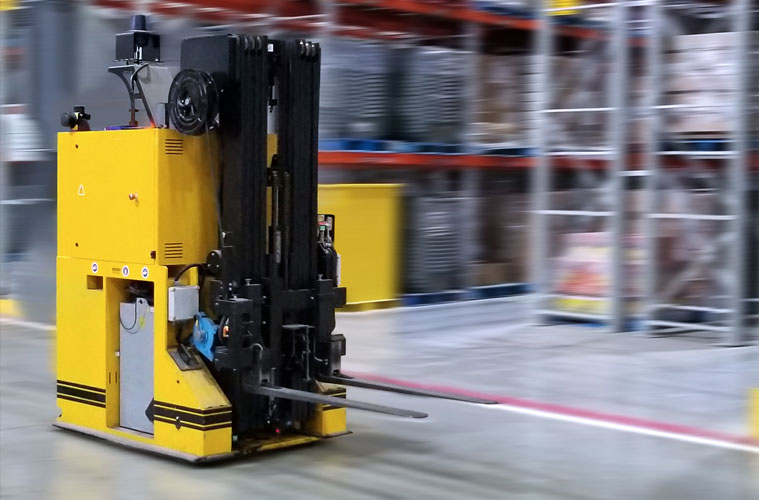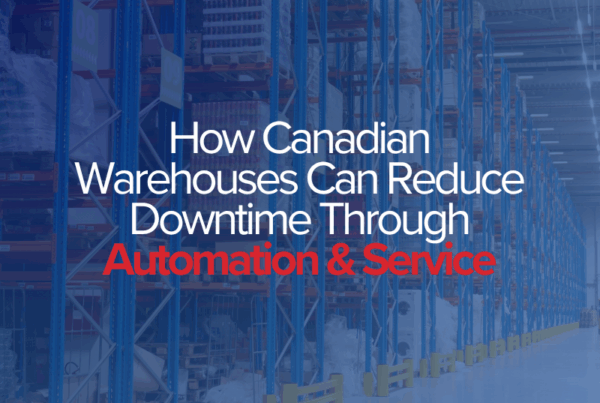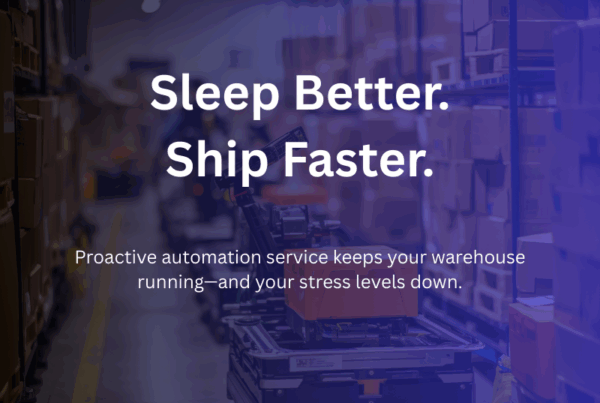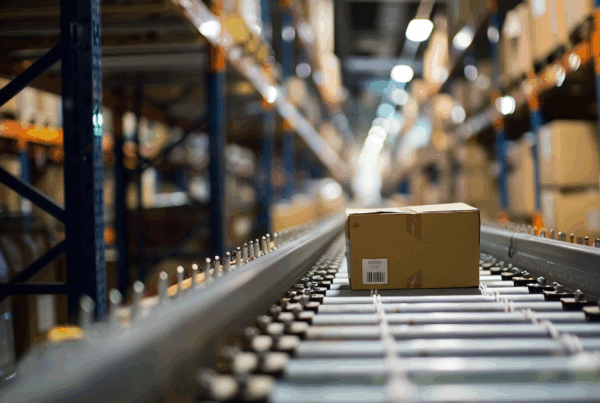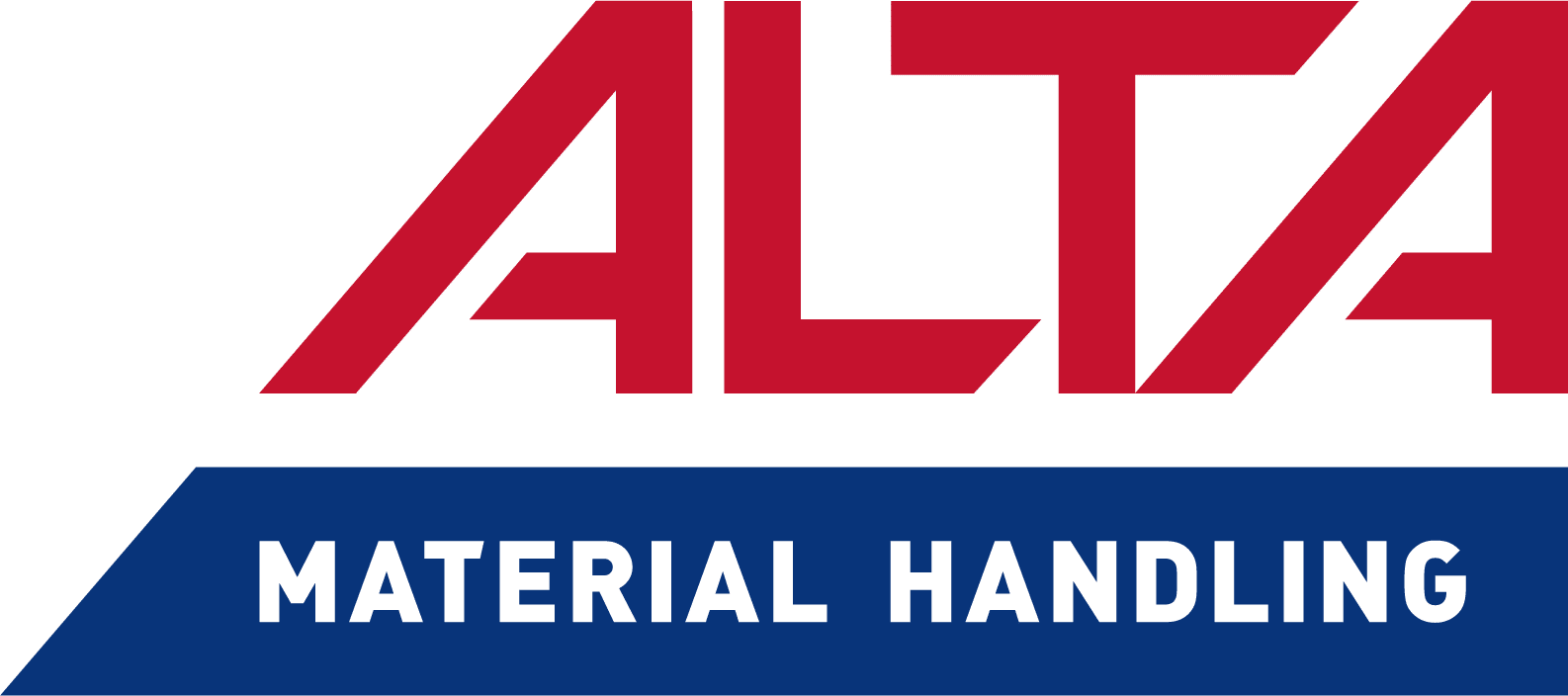What is an automated guided vehicle?
Automated guided vehicles (AGVs) are, put simply, driverless vehicles used to move material. They can look very much like traditional forklifts, though they may lack a cockpit. Depending on the application, they can also take less traditional shapes. Low-profile AGVs may look like industrial Roombas and move material by jacking up shelving from below.
An AGV system (AGVS) is one or more of these vehicles, plus the software and hardware needed to operate them. These may include software or applications that work with a warehouse management system, reflective tape installed on walls and fixtures, magnetic or colored tape installed on the ground to mark the AGV’s travel path, or wires or transponders embedded into the warehouse floor.
Probably the most frequent inquiry we receive at PeakLogix is from those interested in AGVs regards safety. The reality is that they are safer than traditional systems – they reduce the amount of lifting, bending, and twisting that operators are required to perform when working with conveyors, for example. And they are more reliable than drivers and operators.
AGVs are equipped with traffic control and collision avoidance. Traffic control may be run by a warehouse control system, which will know where each autonomous vehicle is in relation to the others and signal each vehicle its turn to move as well as its path. Collision avoidance is often a combination of sonar and a physical-contact sensor installed in the bumper. The sonar works much like a bat’s – high-frequency sounds are emitted, the echoes are interpreted, and the autonomous vehicle is capable of stopping before it impacts anything that may come into its path. As a failsafe, should the autonomous vehicle bump into anything unexpected, the sensor in its bumper will stop the machine immediately.
The benefits of an AGV
In a survey of leading companies in the material handling industry, “attracting and retaining a qualified workforce” was cited by 48% of the respondents as their leading concern. AGVs help address this issue by replacing operators. More than that, however, AGVs are more efficient than their human counterparts. And while their up-front cost can be substantial, they never expect overtime or holiday pay, never call in sick or take vacations, and won’t leave to work for a higher-paying competitor. While there are still costs involved with AGVs – such as maintenance and charging stations – they are smoother and more predictable than labor costs.
AGVs also minimize damages to products, machinery, and infrastructure. They are equipped with collision avoidance so they don’t hit walls, columns, or other infrastructure. At the same time, they can be programmed to handle various products as gently as needed, reducing damages.
Safety is also improved. AGVs follow their guide paths, stay in their zones, and are equipped with safety sensors. Their paths are well marked and should be clear to warehouse staff. However, even if an accident should happen – such as a human tripping in front of an AGV – the vehicles will either stop or turn to avoid the collision. At the same time, they don’t get distracted and never drive impaired.
More than these benefits, however, autonomous vehicles fill a niche in the ecosystem of automation. At PeakLogix, we strive to implement new systems into your existing processes as seamlessly as possible – and AGVs lend themselves to that approach as well as any other technology.
In processes that might include sortation conveyors and batch or wave picking, a warehouse management system can control the timing of a fleet of AGVs, staggering the flow of goods so that uptime is maximized. Unlike other forms of automation such as conveyors or flow-through racking, AGVs can work with minimal changes to your existing layout; they can move product along the same paths as your operators. And as your needs for streamlining your operations increase, aisles can be narrowed and racking changed to make an AGV even more efficient.
Navigating your fleet
The means of navigating should not be confused with collision avoidance. AGVs can navigate by one means (for example, by following a track of magnetic tape) and use another (such as sonar or a camera) for collision avoidance.
The different methods that AGVs use to navigate a workspace fall into a couple of categories. The first are those AGVs that follow a strict route laid out or marked within the facility; these are “guided” vehicles:
- Wired AGVs – Perhaps the most invasive navigation technology, wire guidance still has its place in manufacturing and warehousing. In this system, a channel is cut into the floor in which a wire is set following the AGVs intended path. The wire transmits a radio signal that the AGV detects and follows.
- Guide Tape – This system is similar to wire guidance, but is more easily changed as needed. Instead of a channel being cut in the floor, magnetic or colored tape is simply laid out along the AGVs intended path. The AGV “sees” this tape and follows it. This is less expensive than wire guidance, but requires the tape be replaced if damaged or dirtied.
- Lasers – Laser guided AGVs carry a transmitter and receiver, which emit and detect lasers. Laser guidance requires the installation of reflective tape on walls, machinery, and fixtures. When the laser light is reflected off of this tape, the AGV is able to calculate its place against the map stored in its memory.
- Inertial Navigation – Inertial guidance is a form of dead reckoning. In this system, the AGVs current position is determined based upon previous knowledge of the machine’s position and its velocity. To do this, the AGV is equipped with an array of sensors including accelerometers, gyroscopes, and magnetometers. AGVs that use inertial navigation are not completely autonomous – rather, they communicate with a system of transponders most often embedded in the floor.
The second category of autonomous vehicles still follow a certain route, but don’t require any additions to the workspace to do so. More advanced AGVs (also known as AMRs – autonomous mobile robots) are equipped with sophisticated sensors, use probability theory to plan their routes, and are better able to navigate around obstacles or changes in the environment.
- Natural Targeting – AGVs that use natural targeting (or natural feature) navigation do so without any changes to their environment – no transponders or reflective strips or radio-emitting wires. Instead, the AGV uses a series of complex algorithms as well as inertial navigation and some form of visual guidance – lasers or cameras – to plan the shortest permitted path to its goal.
- Vision Guidance – Vision guided AGVs are guided by cameras that see in the optical range. Features along a route are recorded, and then matched against what the AGV “sees” to plan its current path. Complex probabilistic algorithms enable these robots to determine the chance of occupancy of any given location along its chosen route – which means that they are able to react to changes in their environment in real time, while still following pre-determined paths.
- Geoguidance – The first step in installing geoguided AGVs is to generate an accurate map of the space the AGVs will inhabit. This is done by “walking” the AGV in a guided tour, during which the AGV’s cameras create a map of the space. This map is later cleaned so that only permanent fixtures remain in the AGV’s memory. Finally, routes are programmed that the AGV is to follow. Geoguided AGVs are more tolerant to changes in the environment than are AGVs that use natural targeting.
The various types of AGVs
The types and looks of AGVs are as various as the roles they need to fill. At PeakLogix, we have seen organizations benefit from each of these, and often from more than one operating at the same time, performing different roles in the same warehouse.
Self-guided tuggers
As the name implies, self-guided tuggers are used to pull material. This may be on shelving or carts, or nearly anything else that’s either on wheels or that’s able to be put on wheels, in singles or in trains.
Smaller tuggers might pull trains of merchandise up to a couple of tons (a towing capacity similar to a small car). Larger tuggers can handle loads of as much as 20 tons. Tuggers usually move at about 200ft/min, though of course they may go slower.
There are drawbacks to tuggers. Some may require an operator to hook or unhook them from a trolley. And if the tugger has to move backward for any reason – for example, to hook itself to a trolley – then it’s usually flying blind; the safety lasers on tuggers are all on the front side. There are still bumpers and other safety mechanisms in place, but depending on the need and the space, this may be an important consideration.
Self-guided forklifts and reach trucks
Self-guided forklifts and reach trucks are AGVs equipped to act like, unsurprisingly, forklifts and reach trucks. They have tynes (the forks) and are able to follow their route to a pallet or stack of pallets, lift their pre-programmed load, and carry it to its destination without human intervention.
As with conventional forklifts, there are varying sizes, heights, and capacities. One difference between a conventional forklift and self-guided lifts is that autonomous vehicles are often able to turn more sharply. But if your business is currently using forklifts for an operation, there is an AGV capable of handling the same load.
In businesses that handle pallets repetitively – pulling and putting from and to the same locations – self-guided forklifts will probably make sense.
Unit load GVs
Unit load autonomous vehicles are often the size of a forklift. However, instead of being equipped with tynes, they have decks. These decks may or may not be powered; powered decks allow for automatic load transfer. They may be lift-and-lower (similar to forklifts), or chain or belt driven (similar to conveyors), or custom designed.
These vehicles are great for heavy products and long distances – for example, carrying loads between facilities, or cross docking.
Light load AGVs
Light load autonomous vehicles are made for smaller loads of about 500 lbs. or less. They usually transport baskets of small parts or pieces, or other light loads, throughout a facility. Because they’re used for lighter loads, they can also be much smaller than unit-load AGVs, and can fit into and work within more limited spaces.
These vehicles have many varying shapes. They may look like smaller cousins to their larger unit-load AGVs, or they may have shelves for storage and oversized wheels for better cornering and steering in office environments.
These vehicles may be used to carry mail or even snacks, but are also used for critical functions such as goods-to-person picking systems.
Assembly line vehicles
Not that long ago, AGVs were considered impractical in manufacturing applications because of limitations such as a short battery life. Conveyors were the most practical, efficient means of moving material.
However, not only have modern technologies helped AGVs to compete with conveyors at moving material, but they have also allowed AGVs to solve issues that at first seem unrelated, such as startup costs. These are one of the biggest hurdles to any new business. They are perhaps especially painful in manufacturing, where early production can be limited and business plans often call for a ramp-up to full production. Conveyors – while still a viable option – have to be bought en masse. Track has to be laid, and the amount doesn’t change whether its moving one box or thousands of boxes.
AGVs, on the other hand, can be purchased as needed. In early production phases, a single unit might handle the load. Once the production is running at full speed, an entire fleet of AGVs can be purchased to move the material.
Parts of an AGV system
Many of the parts of an AGV system – the vehicles themselves, the different methods of navigation, and safety controls – we’ve already discussed. But there are other, peripheral concerns that also need to be given light.
Communication
Communication between the AGVs and the control system usually happens over WiFi. Other components – the charging bays, for example – communicate via Ethernet.
Job control
AGVs can be given jobs manually – through a computer input or barcode scanner – or the WMS might generate tasks automatically. Either way, the control system then has to be smart enough to organize the movements of all the AGVs throughout the facility.
The central controller will determine which AGV is to get the command, and when it is to initiate the process. The system also determines the pace of the AGV, so that its load is discharged at the most opportune time to keep the flow of production uniform. At the same time, the movement of all AGVs are accounted for, so that both collisions and bottlenecks are avoided. External components – doors and lifts, conveyor systems, etc. – can also be controlled.
Battery management
An AGV’s batteries can be recharged in a number of ways.
Bays can be set up next to which the AGV parks. The spent battery is removed and a fresh one installed automatically. Or, the AGV might put itself into an idle mode and recharge while parked.
More complicated systems will have opportunities for an AGV to charge during short periods of downtime in its work cycle. Less complicated systems require a person to manually pull a battery out and replace it, or plug in a charging cable.
Applications
Anytime material needs to be moved, an AGV can do it. Of course, this doesn’t make AGVs the right answer all the time. There are many ways to store and retrieve product, and understanding which is right for a given application requires looking at the process and the goals of your business, and choosing which systems make the most sense in terms of costs and efficiencies.
At PeakLogix, our goal is to develop a relationship with your business that allows us to understand your needs, so that we can find the right answer for you.
Want to learn more about automated guided vehicles? Contact us to talk details and strategies.
Reduced costs and increased efficiencies for industrial dry cleaning service
The technologically advanced operations design reduced the space needed for fulfillment, increased the space for storage, and allowed flexibility to grow without expanding the facility’s footprint. Client saw drastic increases in operational efficiencies operations, with some workstations reaching 75% gains.

